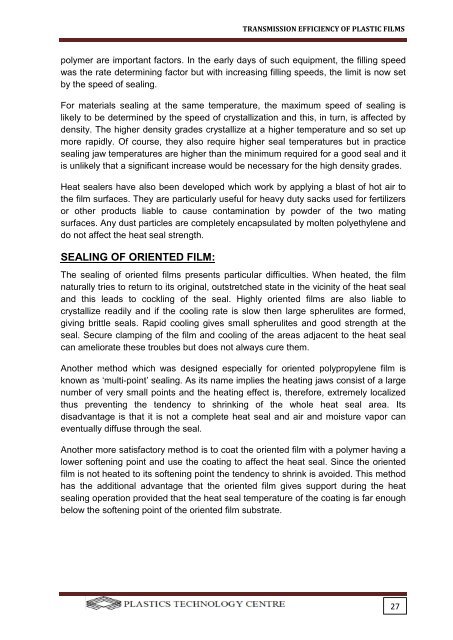Transmission Efficiency of plastic Films Part 1
Create successful ePaper yourself
Turn your PDF publications into a flip-book with our unique Google optimized e-Paper software.
TRANSMISSION EFFICIENCY OF PLASTIC FILMS<br />
polymer are important factors. In the early days <strong>of</strong> such equipment, the filling speed<br />
was the rate determining factor but with increasing filling speeds, the limit is now set<br />
by the speed <strong>of</strong> sealing.<br />
For materials sealing at the same temperature, the maximum speed <strong>of</strong> sealing is<br />
likely to be determined by the speed <strong>of</strong> crystallization and this, in turn, is affected by<br />
density. The higher density grades crystallize at a higher temperature and so set up<br />
more rapidly. Of course, they also require higher seal temperatures but in practice<br />
sealing jaw temperatures are higher than the minimum required for a good seal and it<br />
is unlikely that a significant increase would be necessary for the high density grades.<br />
Heat sealers have also been developed which work by applying a blast <strong>of</strong> hot air to<br />
the film surfaces. They are particularly useful for heavy duty sacks used for fertilizers<br />
or other products liable to cause contamination by powder <strong>of</strong> the two mating<br />
surfaces. Any dust particles are completely encapsulated by molten polyethylene and<br />
do not affect the heat seal strength.<br />
SEALING OF ORIENTED FILM:<br />
The sealing <strong>of</strong> oriented films presents particular difficulties. When heated, the film<br />
naturally tries to return to its original, outstretched state in the vicinity <strong>of</strong> the heat seal<br />
and this leads to cockling <strong>of</strong> the seal. Highly oriented films are also liable to<br />
crystallize readily and if the cooling rate is slow then large spherulites are formed,<br />
giving brittle seals. Rapid cooling gives small spherulites and good strength at the<br />
seal. Secure clamping <strong>of</strong> the film and cooling <strong>of</strong> the areas adjacent to the heat seal<br />
can ameliorate these troubles but does not always cure them.<br />
Another method which was designed especially for oriented polypropylene film is<br />
known as ‘multi-point’ sealing. As its name implies the heating jaws consist <strong>of</strong> a large<br />
number <strong>of</strong> very small points and the heating effect is, therefore, extremely localized<br />
thus preventing the tendency to shrinking <strong>of</strong> the whole heat seal area. Its<br />
disadvantage is that it is not a complete heat seal and air and moisture vapor can<br />
eventually diffuse through the seal.<br />
Another more satisfactory method is to coat the oriented film with a polymer having a<br />
lower s<strong>of</strong>tening point and use the coating to affect the heat seal. Since the oriented<br />
film is not heated to its s<strong>of</strong>tening point the tendency to shrink is avoided. This method<br />
has the additional advantage that the oriented film gives support during the heat<br />
sealing operation provided that the heat seal temperature <strong>of</strong> the coating is far enough<br />
below the s<strong>of</strong>tening point <strong>of</strong> the oriented film substrate.<br />
27



